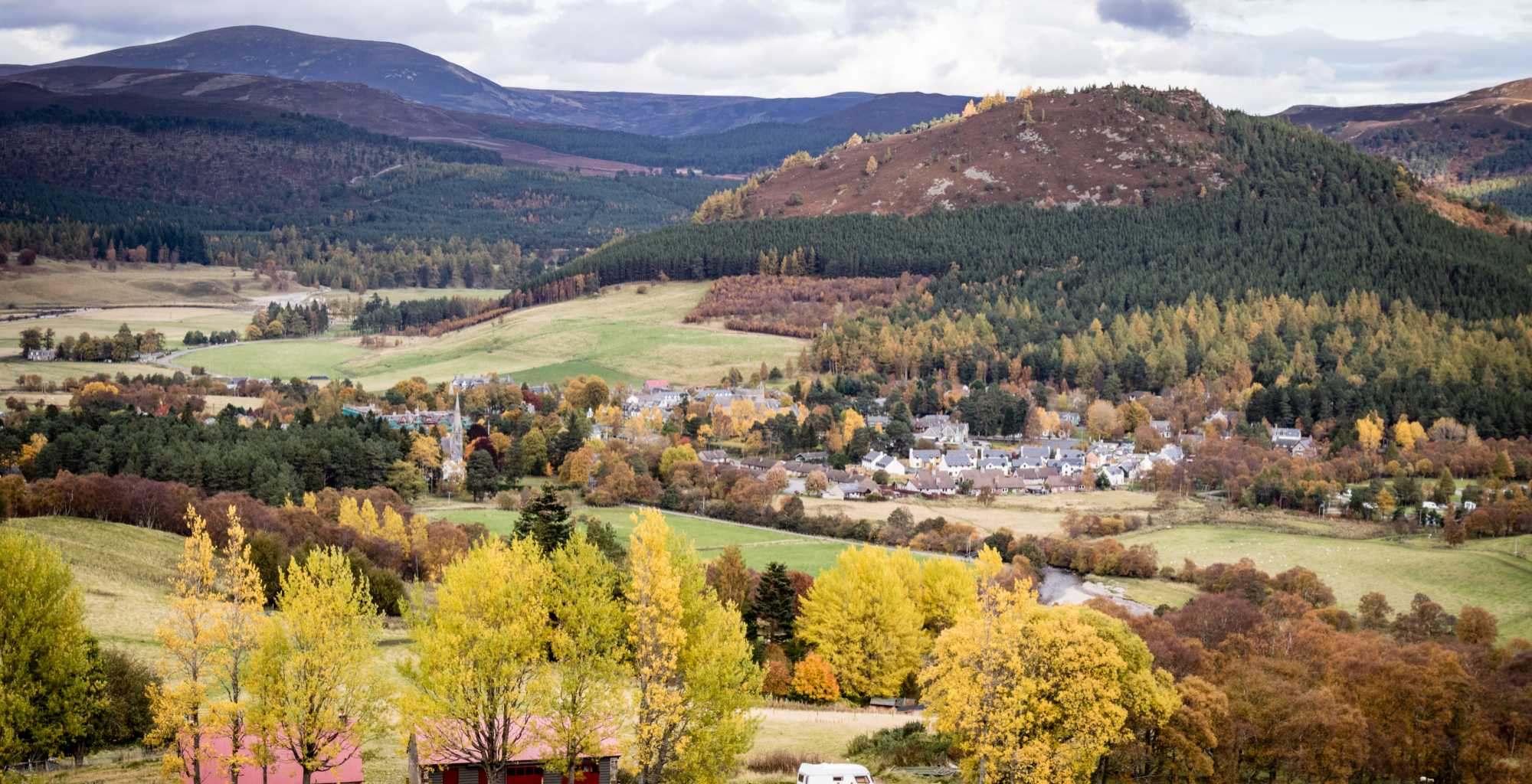
The Best Small Villages in Scotland
What are the best small villages in Scotland?
Renowned for the beauty and splendour of its rugged countryside, Scotland is the most northerly of the four nations that make up the UK, yet many parts of the country are exceedingly well connected to the rest of Britain.
While access to the information highway of superfast broadband may be more challenging to achieve in the more remote rural villages, coverage is growing all the time.
So, let’s take a closer look at some of the best small villages Scotland has to offer the discerning buyer.
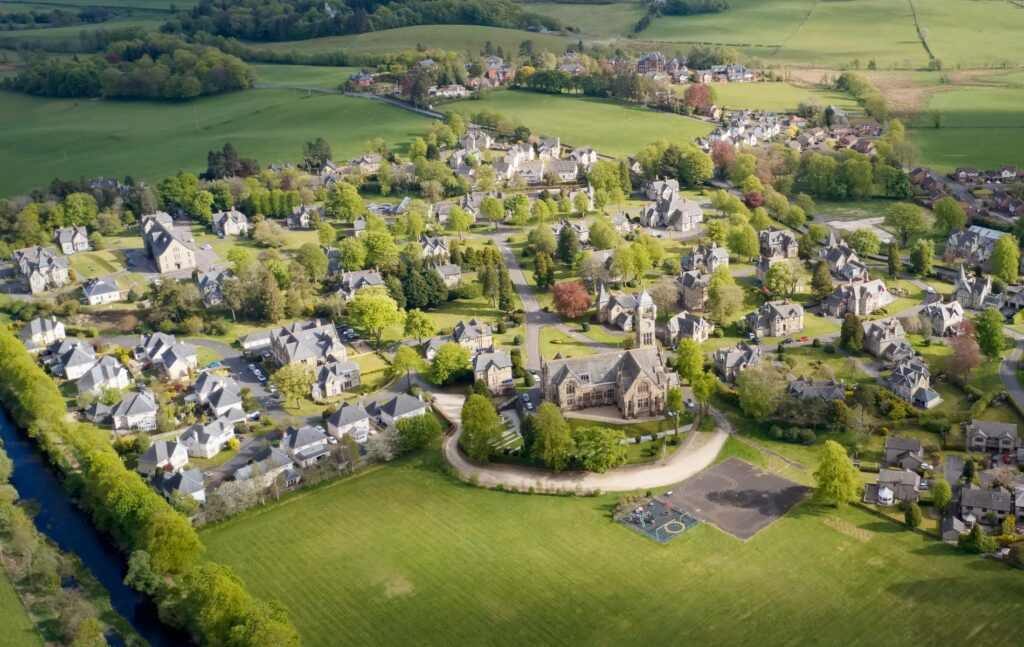
Gifford, East Lothian
Key facts:
- Amenities: The village of Gifford offers something to everyone – it’s a tranquil community surrounded by farmland, yet only 3 miles south of Haddington, the county town of East Lothian. And whenever you fancy a break from village or provincial life, the capital of Scotland, Edinburgh itself, is only 25 miles to the west;
- Education: Yester Primary School is a state school in the village for children aged 3 to 12 and was mostly rated Good in its most recent Standards and Quality Report. The state secondary school (ages 12 to 18) is Knox Academy in nearby Haddington and is one of the world’s oldest schools – first founded as a grammar school in 1379. George Heriot’s School, founded in 1628 and in Edinburgh (25 miles away), is probably the foremost independent school and has some 1,600 pupils in its primary and secondary schools;
- Transport links: despite its rural setting, Gifford is only 25 miles from the Scottish capital of Edinburgh and is also close to the longest-established road between there and London, the A1 and A1(M). Nevertheless, the drive to London can still take around 7½ hours, so most trips to the UK capital will be made by air from Edinburgh Airport (which also serves many international destinations) – a flight of around 11/4 hours;
- Trains: from the railway station in Edinburgh, there are frequent fast trains to Glasgow (about an hour away) and the entire rail network of Scotland. Trains to London King’s Cross will take roughly 4½ to 5 hours.
Why live in Gifford, East Lothian?
Buy a home in the village of Gifford, and you get to live the best of both worlds – all the tranquillity and charm of country living, yet with the county town of Haddington on your near doorstep and Edinburgh itself a short commute away.
Gifford harbours its own secrets and mystery in the shape of Yester Castle. It was built by a local nobleman, Sir Hugo Gifford, in 1267 when rumour had it that he was secretly a wizard who had used his dark arts to build the castle.
The building included a dungeon called the Goblin Hall – or given some locals’ way with words, Goblin Ha’.
Continuing the legend, you and your visitors might even today choose to stay in the local Goblin Ha’ Hotel.
Probably the most famous son of the village was John Witherspoon.
He was born in 1723 but went on to become one of the signatories of the American Declaration of Independence and, later, Princeton University’s first president.
West Linton, Scottish Borders

Key facts:
- Amenities: West Linton is a picturesque conservation village nestled on the edge of the Pentland Hills, some 15 miles southwest of Edinburgh. The village has its own small supermarket (a Co-op), pharmacy, and medical practice but a more comprehensive range of shopping possibilities also exists in Peebles – just 14 miles away – and, of course, Edinburgh;
- Education: West Linton Primary School takes children from the ages of two to 12. Nearby Peebles High School is the local state secondary school – originally Bonnington Park Academy, founded in 1858 – that accepts pupils aged 12 to 18. In nearby Edinburgh is the leading independent George Watson’s College, a co-educational college for pupils aged 3 to 18 that was originally founded in 1741. It has since merged with its twin George Watson’s Ladies College to offer places to a total of some 2,300 pupils;
- Transport links: West Linton is strategically located on the main A702, which runs northeast to the Scottish capital of Edinburgh and southwest to join the arterial M74 motorway – north to Glasgow and south via Carlisle to England and all points south. The latter joins the M6 motorway for a 400-mile road journey to central London which can take more than 7 hours – so, most trips to the UK capital will be made from Edinburgh Airport and a flight of around 11/4 hours;
- Trains: after a 45-minute drive to the railway station in Edinburgh, you will find frequent fast trains to Glasgow (about an hour away) and the entire rail network of Scotland. Trains to London King’s Cross will take roughly 4½ to 5 hours.
Why live in West Linton, Scottish Borders?
Life in West Linton can be enjoyed in the quiet and peaceful surroundings of the rolling countryside of the Scottish borders.
Yet, it is also close to the market town of Peebles and the Scottish capital in Edinburgh.
You will also be steeped in the history of the village itself – said to be one of the longest-established market settlements in the whole of the country.
There is evidence of people living here as early as the Bronze Ages, and during the 17th century, West Linton enjoyed some fame for its lead and silver mining, and its accomplished stonemasons.
Today’s population of around 1,500 is generally wealthier than average, own their own homes, and are either retired or professionals who commute to work in Edinburgh.
Heriot, Mid-Lothian
Key facts:
- Amenities: Heriot lies at an elevation of around 300m up in the Moorfoot Hills and is a small farming village surrounded by moorland and the rolling countryside of the Scottish Borders. A mobile post office calls at Heriot twice a week and also offers mobile banking services. The nearest town is Stow, where you will find a post shop, café, and doctors’ surgery. Other nearby towns are Bonnyrigg (nine miles to the northwest) and Peebles (10 miles southwest);
- Education: there is a village primary school, Heriot Primary School, which shares its head teacher with nearby Fountainhall Primary School. The nearest state secondary school is Peebles High School (ages 12-18) – once known as Bonnington Park Academy when it was founded in 1858 – and has a good reputation in the area. Edinburgh (23 miles away) is home to some of the country’s leading independent schools, including the renowned co-educational George Watson’s College, founded in 1741, for pupils aged 3 to 18;
- Transport links: thanks to its location in the Scottish Borders, Heriot remains well-placed for access to Edinburgh, Glasgow, and both the northwest and northeast conurbations of England. Almost 400 miles away, central London can be reached by road either by the M1 or M6 motorways in a journey time of roughly 73/4, but flights from Edinburgh Airport take just 11/4 hours or so;
- Trains: ScotRail operates local train services from nearby Gorebridge (8 miles from Heriot) to Edinburgh Waverley station – and connections to the entire Scottish rail network, including Glasgow (in about an hour) and London King’s Cross in roughly 4½ to 5 hours.
Why live in Heriot, Mid-Lothian?
The surrounding landscape’s peace, quiet, and tranquillity has attracted its fair share of artists and musicians to Heriot and the surrounding villages – these have included bands such as the Incredible String Band from the 1960s and several potters and painters.
It is a background which continues to give the small settlement of Heriot such a strong sense of community – as evidenced in the activities of its Community Council, Women’s Institute, amateur dramatics group, and even a Wado-Kai Karate club.
One of the little-known claims to fame of Heriot is that it is said that the very last wolf in Britain was shot on Heriot Toun Hill (in around 1750).
Braemar
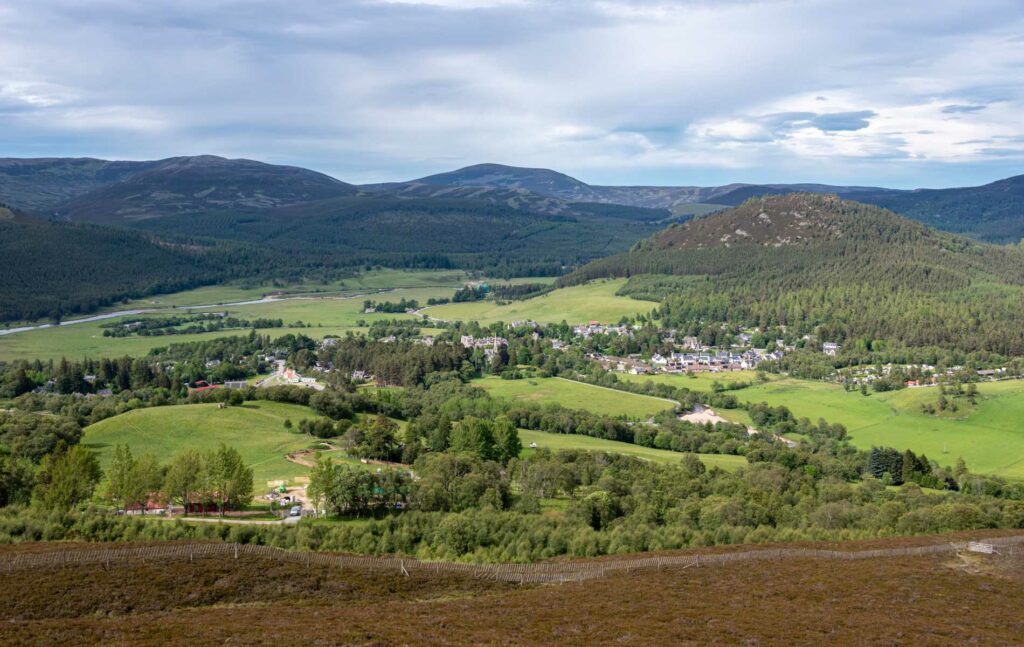
Key facts:
- Amenities: Braemar is the iconic Scottish Highland town forever associated with the Highland Games held yearly on the first Saturday in September. Members of the Royal Family have usually attended these Games, and Braemar attracts its fair share of tourists as a result. Although several shops are catering for the interests of those tourists, there is also a small supermarket (Co-op) and a medical practice;
- Education: Braemar School is a primary school in the village, but it has a very small intake – currently just 32 pupils. The nearest state secondary school is also some distance away, Banchory Academy (ages 11-18), approximately 40 miles away. There are several leading independent schools in Aberdeen (some 57 miles east of Braemar), but probably the best known is 75 miles due north – Gordonstoun School, which was attended in his youth by King Charles III;
- Transport links: Braemar is a remote Highland village but also benefits from the proximity of the economic powerhouse and city of Aberdeen to the east. Here you will also find Aberdeen International Airport, from where you can fly to more than 40 destinations throughout the UK, Europe, and North Africa;
- Trains: from the mainline station at Aberdeen, overnight train services to London Euston take a little over 10 hours, while the journey to Edinburgh takes roughly 2½ hours.
Why live in Braemar?
Braemar is a remote Highland village, and the warmth of its welcoming community was reason enough for its inclusion in our earlier roundup of remote but sought-after places to live in the UK.
The village has very definite and long-established connections with British royalty.
Not only is it host to the Highland Games, which are regularly attended by the monarch, but it is also just 11 miles or so from the castle at Balmoral, where the Royals have their favourite summer residence.
The peace and quiet of remote Highland living may be punctuated by a relatively steady flow of visitors and tourists – attracted by the prospects of a royal presence – but this also means that the village is well served by various local shops.
For the brighter lights of city life, Aberdeen is only 57 miles away (a drive of around an hour and a half).
Cruden Bay

Key facts:
- Amenities: the quaint fishing village and picturesque coastline of Cruden Bay, just 26 miles north of Aberdeen, makes it a popular location for visitors, golfers, and residents after a peaceful life on the Scottish coast. It has its own village stores, including a pharmacy within the local newsagents, post office, and hardware store, while the full range of shops can be found in Aberdeen;
- Education: the local Port Erroll School has around 100 primary pupils aged 5-11, while the nearest secondary school is Peterhead Academy, a six-year Comprehensive Community School, some 8 miles to the north. The leading independent school in nearby Aberdeen is the co-educational (ages 2-18) Albyn School, originally founded in 1867 for girls only but transformed into an educational establishment in 2005;
- Transport links: Cruden Bay’s location on the Buchan Coast makes it a relatively remote village in which to live, although Aberdeen is a drive of only some 35 minutes away, where the International Airport serves more than 40 destinations throughout the UK, Europe, and North Africa;
- Trains: Aberdeen is also the nearest mainline railway station, with services to Edinburgh taking approximately 2½ hours and – relatively popular – overnight services to London’s Euston station taking a little over 10 hours.
Why live in Cruden Bay?
Elsewhere, we have already identified Cruden Bay as one of the best seaside places to live in the UK.
It is hardly surprising that it is such a sought-after village – of around 1,600 people – in which to live because it has it all.
The quaint fishing village is fronted by 2½ miles of sandy beaches from which you can fish, swim or engage in various water sports.
You can also play golf on the internationally famous 27 holes of the Cruden Bay Golf Course or indulge in some retail therapy in the bustling city of Aberdeen not so far from your doorstep.
Or you can venture into the wilds of the Cairngorms National Park for your hiking, winter sports and wildlife.
On the outskirts of the village of Cruden Bay lie the ruins of Slains Castle – a brooding monument darkening the skyline, where the tale of Count Dracula is said to have been written.
Johnshaven
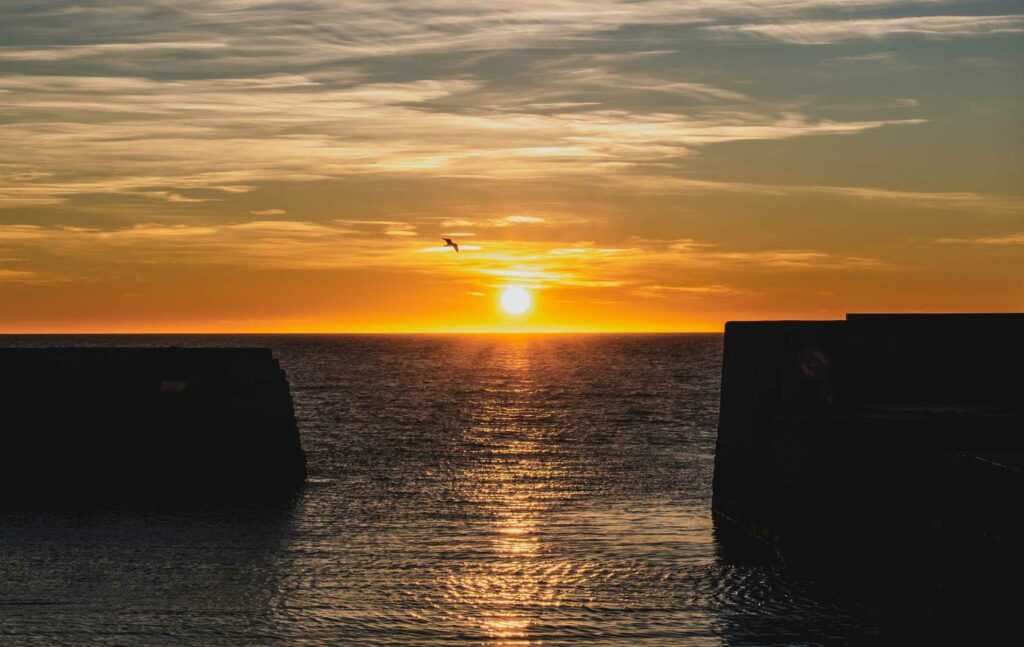
Key facts:
- Amenities: Johnshaven Stores – for all manner of general supplies and food – is described as “one of the hearts of the village”. A more comprehensive selection of shops, including the local medical practice, can be found in Stonehaven, some 14 miles to the north, or – a further 16 miles from Stonehaven – the city of Aberdeen;
- Education: the village has a small Johnshaven Primary School for pupils aged 5-12. State secondary students (ages 12-18) progress to Mackie Academy in Stonehaven. To the north of the village also lies Lathallan School, a leading co-educational day and boarding independent school for primary, junior, and secondary students;
- Transport links: although the village of Johnshaven is on the relatively remote East Coast of Scotland, the cities of Aberdeen (30 miles to the north) and Montrose (just 10 miles to the south) make it well-connected by road to the rest of Scotland. Dundee is approximately an hour’s drive away and Edinburgh itself just 106 miles (roughly 2½ hours drive to the south). Flights from Aberdeen International Airport serve 40 destinations throughout the UK, Europe, and North Africa, while those from Edinburgh International Airport serve even more – including the UK, Europe, North and Central America, and the Middle East;
- Trains: the mainline station at Montrose (10 miles away) offers fast trains to Edinburgh that make the journey in around two hours. You can access the entire Scottish rail network from Edinburgh or travel to London King’s Cross within 4 to 5 hours.
Why live in Johnshaven?
Johnshaven is a pretty fishing village set on the East Coast of Scotland on the attractive coastal plains of the Mearns just off the main A92 trunk road south to Montrose.
Johnshaven has a well-respected maritime history and continues to support an internationally important lobster and other shellfish industry.
In 1722, it was home to 26 boats operated by 130 fishermen – making the village among the most significant fishing communities in the whole of Scotland at the time.
Within its modern maritime world, the village hosts a nationally and internationally acclaimed Fish Festival throughout the first two weeks of August each year.
The festival season closes with a major firework display.
Johnshaven is described as having a strong sense of community, offering a place where you can sit back and enjoy a more tranquil pace of life.
Killin, Stirlingshire
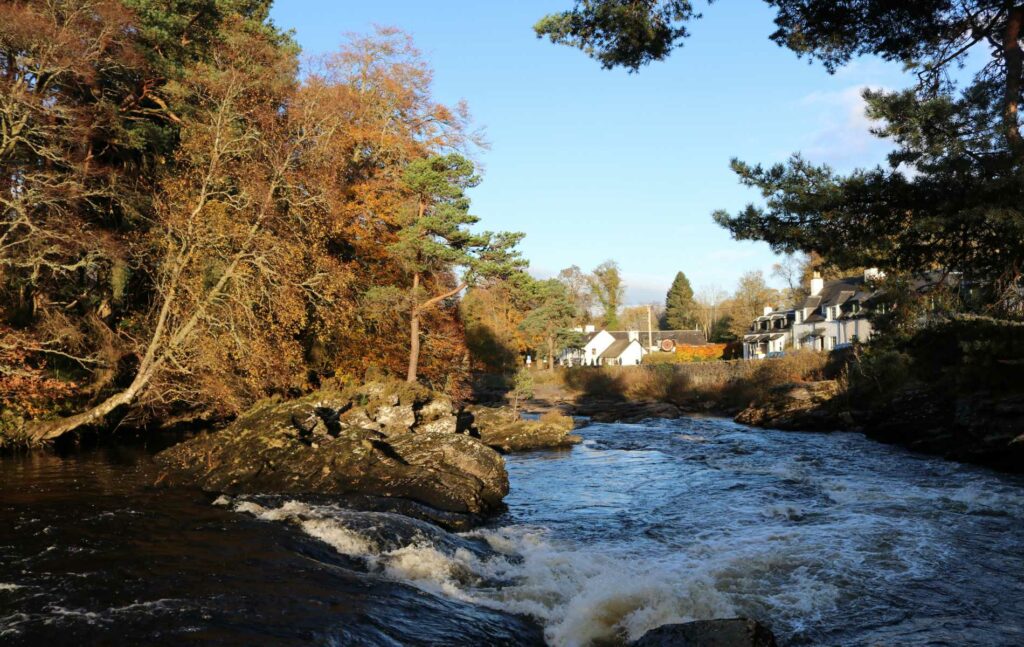
Key facts:
- Amenities: for a small village with a population of just 650 souls, Killin is surprisingly well equipped with local shops – from a small Co-op general store to Davidsons Chemist, a medical practice, hardware store, newsagent, thrift shop, outdoor activities centre, and gift shop. There is a wider selection of local shops in Callander, 22 miles to the south, and still more in the regional centre of Stirling (38 miles to the south);
- Education: the village maintains its own small primary school (of just three classrooms), Killin Primary School. The principal state secondary school (ages 12-18) is McLaren High School in Callander. Just to the north of Stirling, at the Bridge of Allan, is the independent Fairview International School, where pupils engage in a minimum number of hours of foreign language training and study for the International Baccalaureate (IB);
- Transport links: Tucked away in a quiet corner of the Trossachs, Killin is only a relatively short 63-mile drive (roughly an hour and a half, depending on traffic) through the National Park to Scotland’s second city of Glasgow. From here, the M74 and M6 motorways cross the border into northern England and, eventually, to London. The journey is made more quickly and conveniently (about 1½ hours) by air from Glasgow Airport, which also serves more than 100 destinations throughout the UK, Europe, the Middle East, North America, and the Caribbean;
- Trains: the mainline railway station is at Stirling, where train services reach Edinburgh in just under an hour and Glasgow in 40 minutes or so.
Why live in Killin, Stirlingshire?
Killin is a small village on the northeastern tip of Loch Lomond and The Trossachs National Park, on the edge of Loch Tay at the Falls of Dochart, where the Rivers Dochart and Lochay meet.
In the local Gaelic language, Killin or “Cill Fhinn” means “the White (or Fair) Church”.
The village is located within a designated conservation area inside the Loch Lomond and the Trossachs National Park.
It is a fairly long sliver of a parish – some 28 miles in length and 7 miles wide.
Killin is known for its cultural and historical associations – the place where the Celtic priest St Filian established a monastery nearby and where he is said to have preached during the latter part of the 7th century – the village still has guardianship of his healing stones.
In addition to the historical interest, today’s visitors are keen on walking in the stunning countryside roundabout, fishing for salmon, and water sports on the rivers and loch.
St. Fillans, Perthshire
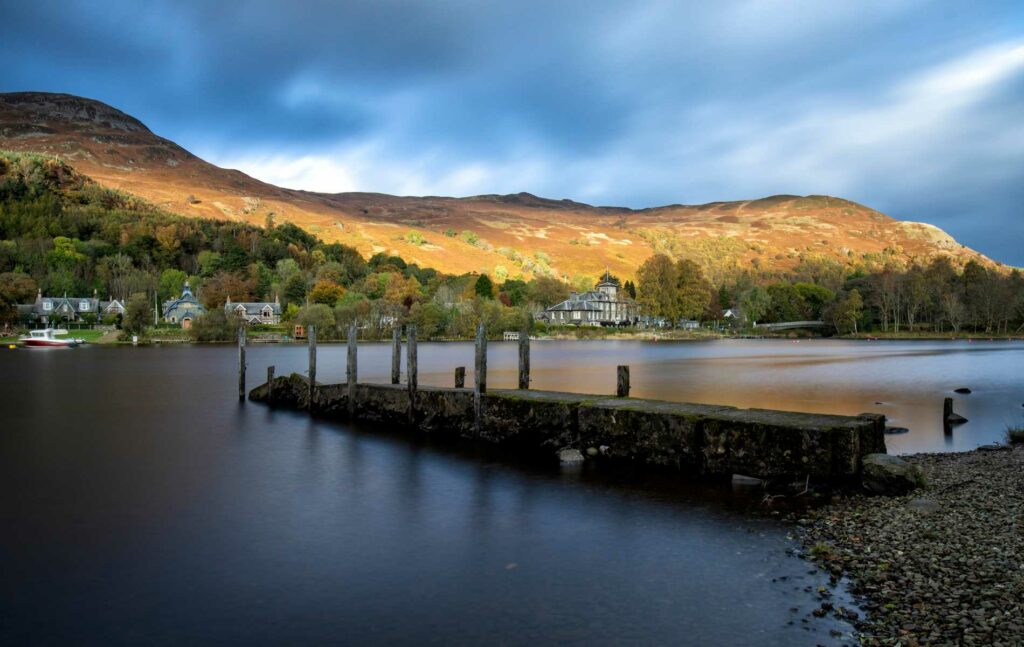
Key facts:
- Amenities: St Fillans is a small village – a population of roughly 200 – in Loch Lomond and The Trossachs National Park at the eastern end of Loch Earn. Groceries – along with tobacco, hardware, fishing tackle, and packed lunches – can be bought at the village store, which is open every day from spring until autumn. More shops and a medical practice can be found in the nearby town of Comrie (5 miles away);
- Education: the nearest primary school (ages 5-12) is also at Comrie. St Fillians is also in the catchment area for the state secondary Crieff High School, 12 miles to the east of the village. 31 miles to the east of St Fillans at Forgandenny just south of Perth is the leading independent, co-educational day and boarding school for pupils aged 7-18, Strathallan School, which occupies some 153 acres of parkland;
- Transport links: St Fillans is in that strategically commanding location approximately midway between the conurbations of both Edinburgh and Glasgow and the Highlands of Cairngorms National Park. Edinburgh is around 68 miles away, a drive of roughly an hour and 40 minutes, while Glasgow is 56 miles away or a drive of roughly an hour and 30 minutes. From the airports in either of these cities, you can fly to more than 100 destinations throughout the UK, Europe, the Middle East, and North America;
- Trains: the rail network is patchy in this part of Scotland, and the nearest mainline station is at Perth, some 31 miles away, with trains to Edinburgh that take approximately 1½ – 2 hours.
Why live in St. Fillans, Perthshire?
St Fillans is a very small village – with a population of around 250 – located at the end of Loch Earn, on the banks of the River Earn as it flows east towards the Tay estuary, some 47 miles away.
It has been described as one of the country’s picture-perfect villages, with a fascinating historical heritage, set in naturally beautiful countryside.
For these reasons, it has long attracted the wealthy and well-heeled – as evidenced by the grand stone houses built along the shores of the loch during Victorian times.
On the very eastern edge of Loch Lomond and The Trossachs National Park, the village attracts its fair share of visitors.
But you can be certain of a generally peaceful and tranquil lifestyle – with the occasional visit, perhaps, to the nine-hole St Fillans Golf Course laid out by professional golfer Willie Auchterlonie in 1903.
Kinloch Rannoch, Perthshire
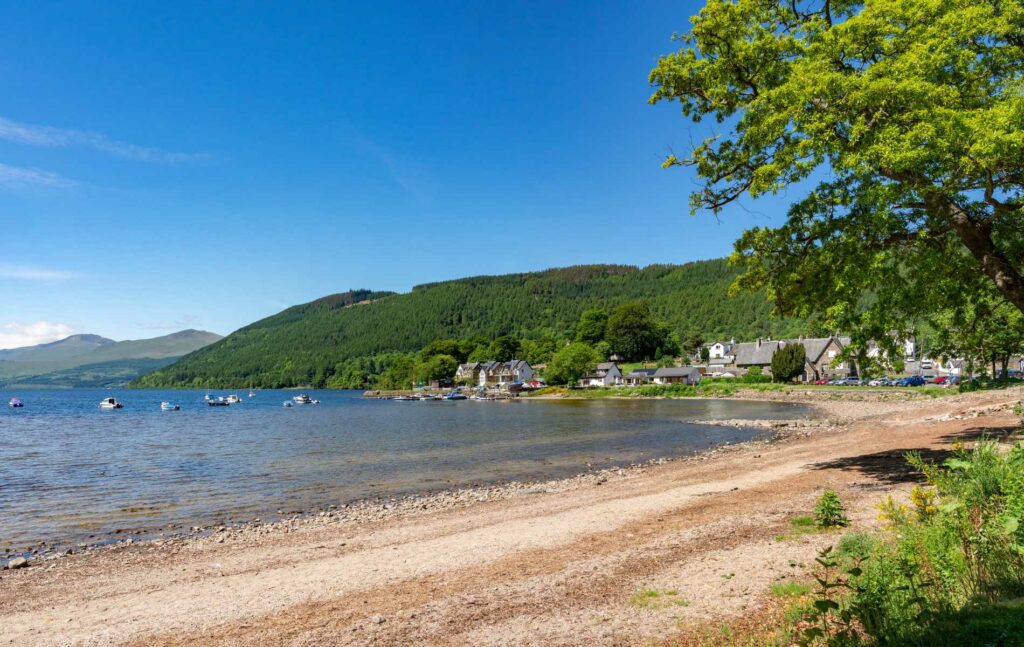
Key facts:
- Amenities: Kinloch Rannoch sits at the eastern end of Loch Rannoch, and this picture postcard Victorian village serves the area with a collection of local shops providing essential amenities, two hotels, a café, a local gallery for passing tourists, and a doctors’ surgery;
- Education: the village maintains its own very small primary school Kinloch Rannoch Primary School – which has fewer than two dozen pupils. The state secondary Pitlochry High School (ages 12-18) is slightly over 20 miles along the valley to the east. The most prestigious independent school close to Kinloch Rannoch is around 55 miles away – to the south of Perth is the leading independent co-educational day and boarding school for pupils aged 7-18, Strathallan School, which occupies some 153 acres of parkland;
- Transport links: the village lies close to the main trunk road, the A9, which, along with the M90, provides quick links by road to the Scottish capital, Edinburgh, approximately 95 miles to the south or a drive taking a little over two hours. From Edinburgh Airport, you have the choice of more than 100 destinations throughout the UK, Europe, North Africa, the Middle East, and North America;
- Rail: from the mainline railway station at Pitlochry (20 miles away), services to Edinburgh take approximately 2 hours – and from there, you have access to the entire Scottish rail network and fast trains to London King’s Cross within 4-5 hours.
Why live in Kinloch Rannoch, Perthshire?
You’ll certainly be far from the madding crowds if you decide to come and live in Kinloch Rannoch – since you’ll be one of a population of no more than 250 or so.
Its very name is descriptive. In Gaelic, Kinloch Rannoch translates as “Ceann Loch”, which means simply “End of the Loch” – and that gives this small village its stunning vistas over the water to the mountains beyond. It is the iconic beauty of Highland Perthshire at its best.
The breathtaking scenery attracts its fair share of visitors, but this also lends business to the excellent village shop, The Country Store.
Plus, a café alongside the village square, two hotels, a gift shop, an art gallery, and even the most modern of amenities – public charge points for electric vehicles (EVs).
Shieldaig

Key facts:
- Amenities: Shieldaig is a remote village on the west coast of Scotland on the north-western edge of the Highlands. Nevertheless, the small village supports a small supermarket, Shieldaig Stores, which also houses a café called Nanny’s. Torridon Medical Practice is also nearby. There are a few more local shops – including a Post Office – in Kinlochewe, some 17 miles away, but for anything more, you will need to cross the country to Dingwall (56 miles) or Inverness (68 miles);
- Education: Shieldaig Primary School is a small primary school with only one full-time teacher, a visiting PE teacher, a visiting music teacher, and a part-time classroom assistant. State secondary schools in the Highlands of Scotland have very large catchment areas. The closest establishment for Shieldaig is the six-year secondary school Gairloch High School (37 miles away). From this remote corner of the Highlands, you might consider the independent boarding school – alma mater of King Charles III – Gordonstoun School, which is on the opposite coast of the country some 110 miles away or a drive of something over 2½ hours;
- Transport links: you have not decided to settle in Shieldaig for any ease of transport to other parts of the UK or abroad – the village is remote. Glasgow may be “only” 200 miles to the south, but that is still a drive along Highland roads of nearly 5 hours. Edinburgh is slightly further away and will take around the same time to drive. International flights are available from either Edinburgh or Glasgow, while the regional airport at Inverness might be useful for flights to London, Ireland, or the Netherlands;
- Rail: the nearest mainline railway station is in Inverness. Trains from here take around 3½-4 hours to Edinburgh, a similar time to Glasgow, and 8-9 hours to London.
Why live in Shieldaig?
Shieldaig is a remote picturesque village on the west coast with a small population. Many people look to come here to escape the hustle and bustle of the towns.
The lochside location is ideal for keen anglers and echoes the reasons for the very founding of the village in 1800 – when incomers were encouraged to take up fishing for their living. A side benefit of that policy was the training in maritime skills for sailors who could be pressed into service with the Royal Navy to fight in the Napoleonic wars.
Many of the houses built at the start of the 19th century and the thriving boat-building industry had funds from the Admiralty in London to thank.
While fishing in the well-stocked waters of the sea lock remains an attraction today, Shieldaig also retains a great community spirit and welcomes the visitors who also come for hiking in the surrounding mountains.
Strathpeffer
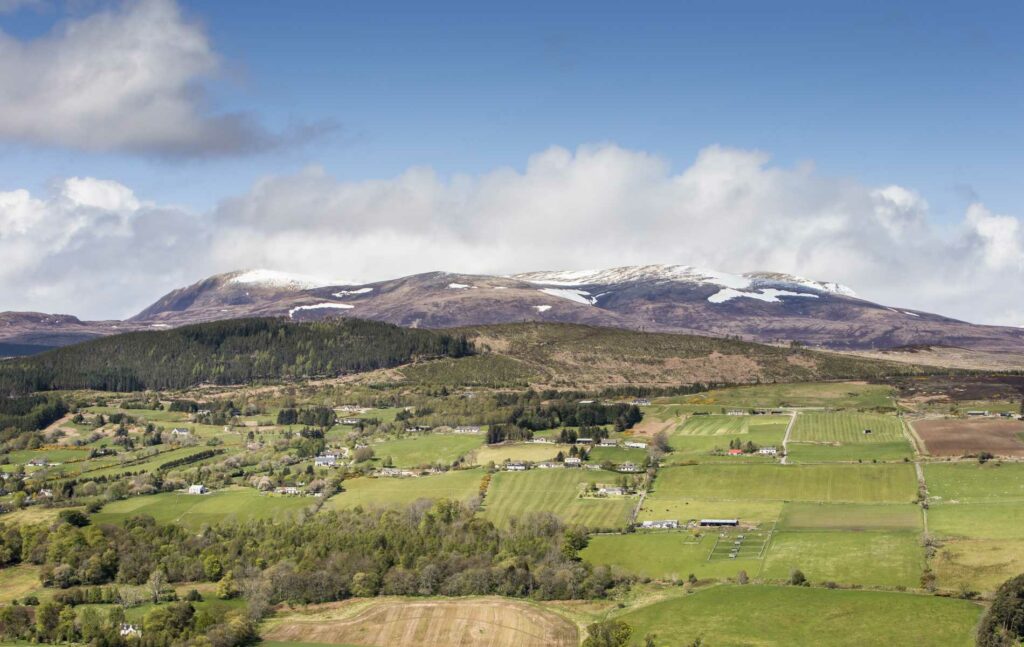
Key facts:
- Amenities: although its population barely numbers 1,500, Strathpeffer in the Ross and Cromarty Highlands of Scotland supports a village convenience store (McColl’s), craft shop, deli, pharmacy, and the Strathpeffer Medical Practice. For a wider range of shops and facilities, the town of Dingwall is just 5 miles to the east;
- Education: the small Strathpeffer Primary School employs seven full-time and two job-share teachers. Students move on to Dingwall Academy, the largest state secondary school in the Highlands of Scotland, with a little more than 1,000 students. Some 60 miles east of Strathpeffer, across the Moray Firth, is one of the country’s leading independent, co-educational, day and boarding schools, Gordonstoun School, which was attended in his youth by the now King Charles III;
- Transport links: although the small town is situated in the Highlands of Ross and Cromarty, it also lies close to the main north-south trunk road, the A9 – which connects the very north of Scotland at Thurso, and via the M90 to the capital Edinburgh in the south. The distance to Edinburgh is approximately 174 miles – a drive that takes around 2½ hours. From Edinburgh Airport, you have the choice of flying to more than 100 destinations throughout the UK, Europe, the Middle East, and North America;
- Trains: the nearest railway station is at Dingwall, and services from there to Edinburgh are made in a journey time of 4-5 hours.
Why live in Strathpeffer?
Strathpeffer is a leafy spa town that grew popular with tourists and visitors in Victorian times.
Overshadowed by the gloomy peak of Ben Wyvis, the regional urban hubs of Dingwall and Inverness make Strathpeffer just as popular with today’s tourists who come for golf, hiking, and mountain biking.
Indeed, the “Strathpuffer” – a 24-hour endurance race for mountain bikers – is held here each year in mid-January and has even attracted the likes of celebrity biker Guy Martin.
If you are happier reliving the gentility of the Victorian leisured classes, however, you will be pleased to know that its glory days as a famous European spa will be revived.
The former Pump Room is being restored so that you, too, can drink the waters that are said to cure all kinds of ailments.
The Best Small Villages in Scotland
Scotland has seen its popularity soar as a place to live, experiencing fast-rising appeal to property buyers and in recent years, at times its been recorded that homes here have been selling faster than in any other part of the UK.
As property finders, we often assist clients in deciding the best small villages in Scotland as a place to live based on their individual requirements and preferences.
Please do get in touch with one of Garrington’s team to discuss how we can best assist you in your search.



